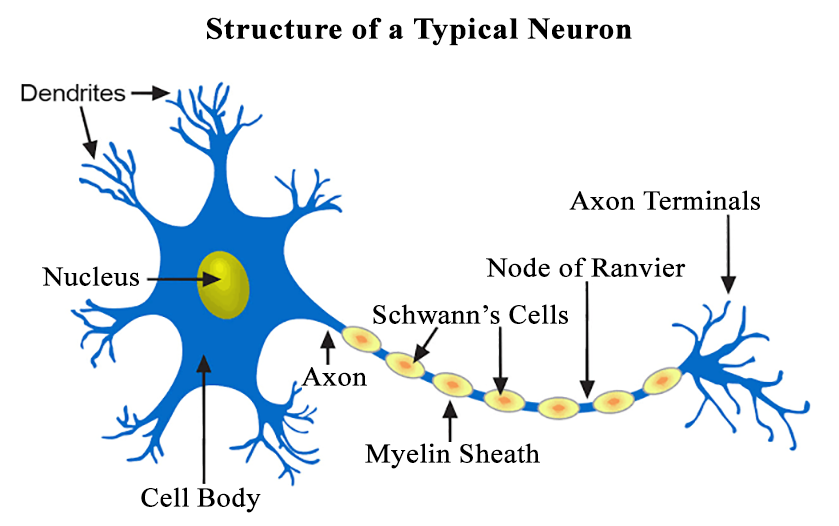
: What is the function of nerve cells?
(a)Nerve cells receive messages from different parts of the body.
(b)Nerves transfer the messages to the brain.
(c)The brain sends commands for the functioning of different organs of the body via nerves.
(d)All of the above
Answer
579.3k+ views
Hint: The nerve cell neurons have to perform a very important function of transferring instructions generated by the brain in the form of nerve impulses, according to which different functions of our body take place.
Complete answer:
-Nerve cells receive messages from different parts of the body and transfer the messages to the brain. The brain sends commands for the functioning of different organs of the body via nerves.
-Whenever a sensory receptor receives information from the environment, the end of the dendrite tip sets of a chemical reaction to create an electrical impulse. This impulse travels from the dendrite to the cyton and then through the axon reaches the axon ends.
-As the message gets transferred from one neuron to another, it finally reaches the muscle cells or glands (effector organ) based on which the impulses will be converted into action.
-Neuron comprises a cyton or cell body which consists of a nucleus, mitochondria, Golgi body, and endoplasmic reticulum. The axon is an extension of the dendrites and it consists of axolemma, myelin sheath, and neurilemma. The small branching of the cyton is the dendrites.

So, the correct answer is “all of the above”
Note: -The mitochondria in the muscle cells are comparatively larger in number to produce energy for muscular action.
-At the end of the axon, the electrical impulse releases some chemicals, these chemicals cross a gap or synapse by creating a potential difference through the accumulation of ions.
-The human body contains about 100 billion neurons in the brain and 13.5 million neurons in the spinal cord.
-Depending upon the location and functions to be performed neurons have different shapes and sizes.
Complete answer:
-Nerve cells receive messages from different parts of the body and transfer the messages to the brain. The brain sends commands for the functioning of different organs of the body via nerves.
-Whenever a sensory receptor receives information from the environment, the end of the dendrite tip sets of a chemical reaction to create an electrical impulse. This impulse travels from the dendrite to the cyton and then through the axon reaches the axon ends.
-As the message gets transferred from one neuron to another, it finally reaches the muscle cells or glands (effector organ) based on which the impulses will be converted into action.
-Neuron comprises a cyton or cell body which consists of a nucleus, mitochondria, Golgi body, and endoplasmic reticulum. The axon is an extension of the dendrites and it consists of axolemma, myelin sheath, and neurilemma. The small branching of the cyton is the dendrites.

So, the correct answer is “all of the above”
Note: -The mitochondria in the muscle cells are comparatively larger in number to produce energy for muscular action.
-At the end of the axon, the electrical impulse releases some chemicals, these chemicals cross a gap or synapse by creating a potential difference through the accumulation of ions.
-The human body contains about 100 billion neurons in the brain and 13.5 million neurons in the spinal cord.
-Depending upon the location and functions to be performed neurons have different shapes and sizes.
Recently Updated Pages
Why are manures considered better than fertilizers class 11 biology CBSE

Find the coordinates of the midpoint of the line segment class 11 maths CBSE

Distinguish between static friction limiting friction class 11 physics CBSE

The Chairman of the constituent Assembly was A Jawaharlal class 11 social science CBSE

The first National Commission on Labour NCL submitted class 11 social science CBSE

Number of all subshell of n + l 7 is A 4 B 5 C 6 D class 11 chemistry CBSE

Trending doubts
10 examples of friction in our daily life

One Metric ton is equal to kg A 10000 B 1000 C 100 class 11 physics CBSE

Difference Between Prokaryotic Cells and Eukaryotic Cells

1 Quintal is equal to a 110 kg b 10 kg c 100kg d 1000 class 11 physics CBSE

State the laws of reflection of light

Explain zero factorial class 11 maths CBSE




